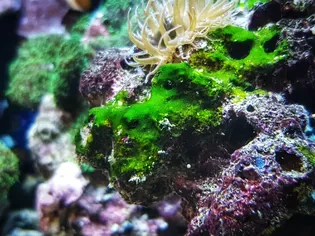Cyanobacteria or Blue-Green Algae in an Aquarium
Updated on 04/26/24

Unmasking the Enigma of Cyanobacteria in Aquariums: A Comprehensive Guide to Eradication and Prevention
Cyanobacteria, often referred to as blue-green algae, are not true algae but rather a type of bacteria. They are common inhabitants of aquatic environments, including aquariums. While they can provide some benefits to an aquarium ecosystem, such as oxygen production and nutrient cycling, they can also become a nuisance when they proliferate excessively. In this comprehensive guide, we will delve into the world of cyanobacteria, exploring their characteristics, causes of proliferation, and effective strategies for eradication and prevention.
Characteristics of Cyanobacteria
Cyanobacteria are a diverse group of bacteria that exhibit a range of colors, including blue-green, green, brown, and even red. They are typically found attached to surfaces within the aquarium, such as rocks, plants, and substrate. Cyanobacteria can form visible colonies, often resembling mats or films, which can be unsightly and impact the overall aesthetics of the aquarium.
Causes of Cyanobacteria Proliferation
Excess nutrients, particularly nitrates and phosphates, are the primary drivers of cyanobacteria blooms in aquariums. These nutrients can accumulate from various sources, such as overfeeding, decaying organic matter, and improper filtration. Inadequate water flow and poor lighting conditions can also contribute to the growth of cyanobacteria.
Consequences of Cyanobacteria Blooms
While cyanobacteria can be beneficial in small quantities, excessive proliferation can have detrimental effects on the aquarium environment. Cyanobacteria blooms can:
* Impair Water Quality: Cyanobacteria consume oxygen, which can lead to low dissolved oxygen levels in the water, causing stress or even death to fish and other aquatic organisms.
* Produce Toxins: Some species of cyanobacteria can produce toxins that are harmful to fish, invertebrates, and even humans.
* Block Light: Dense cyanobacteria colonies can block sunlight from reaching plants, hindering their growth and photosynthesis.
* Unsightly Appearance: Excessive cyanobacteria growth can make the aquarium unsightly and detract from its overall appeal.
Eradication of Cyanobacteria
Eradicating cyanobacteria from an aquarium requires a multi-pronged approach. The following steps can help effectively control and eliminate cyanobacteria blooms:
* Water Changes: Regular water changes help remove excess nutrients and reduce cyanobacteria populations.
* Nutrient Reduction: Limit feeding and remove decaying organic matter promptly to minimize nutrient levels.
* Improved Filtration: Invest in an efficient filtration system that includes both mechanical and biological filtration to remove nutrients and bacteria.
* UV Sterilization: UV sterilizers can effectively kill cyanobacteria cells, but it's important to note that they do not eliminate the underlying causes of the bloom.
* Chemical Treatment: In severe cases, chemical treatments specifically designed to target cyanobacteria may be necessary. However, these treatments should be used with caution and according to the manufacturer's instructions.
Prevention of Cyanobacteria Blooms
Preventing cyanobacteria blooms is crucial for maintaining a healthy aquarium. Implementing the following measures can help minimize the risk of future outbreaks:
* Regular Maintenance: Perform routine water changes, clean the filter media, and vacuum the substrate to remove excess nutrients and organic matter.
* Avoid Overfeeding: Feed your fish only as much as they can consume in a few minutes to prevent uneaten food from accumulating.
* Adequate Lighting: Provide appropriate lighting to support plant growth, which can help outcompete cyanobacteria for nutrients.
* Good Water Flow: Ensure sufficient water flow throughout the aquarium to prevent nutrient buildup and provide oxygenation.
Case Studies: Examples of Successful Cyanobacteria Eradication
To illustrate the effectiveness of the strategies discussed above, let's examine a few case studies:
* Case Study 1: An aquarium with a severe cyanobacteria bloom was treated with regular water changes, improved filtration, and nutrient reduction. Within a few weeks, the cyanobacteria population was significantly reduced, improving water quality and the overall aesthetics of the aquarium.
* Case Study 2: Another aquarium experienced a cyanobacteria outbreak due to overfeeding. By restricting feeding and implementing a more rigorous cleaning schedule, the cyanobacteria proliferation was controlled without the need for chemical treatments.
* Case Study 3: UV sterilization was successfully employed in an aquarium with a persistent cyanobacteria bloom that other methods failed to eradicate. The UV sterilizer eliminated the cyanobacteria cells, restoring the aquarium to its previous clarity.
Conclusion
Cyanobacteria can be a nuisance in aquariums, but with proper understanding and management techniques, they can be effectively controlled and prevented. By implementing the strategies outlined in this guide, aquarium owners can maintain a healthy and aesthetically pleasing environment for their aquatic inhabitants. Remember, regular maintenance, nutrient reduction, and appropriate lighting are key to preventing cyanobacteria blooms, while prompt action and targeted treatments can effectively eradicate existing infestations.
Explore More Pets

Freshwater Aquarium Filters
How to Deal With Cloudy Aquarium Water

Saltwater Aquarium Filters
How Do You Remove Chloramines From Tap Water?

Freshwater Aquariums & Habitat
Can I Keep My Koi Fish Inside?

Saltwater Aquariums & Habitat
14 Best Floating Plants for Your Aquarium

Freshwater Fish Health
How to Treat Ich on Freshwater Fish

Saltwater Fish Health
Fin Rot in Aquarium Fish

Freshwater Aquarium Filters
How to Do Aquarium Water Changes

Saltwater Fish Health
How Do Fish Get Parasites?